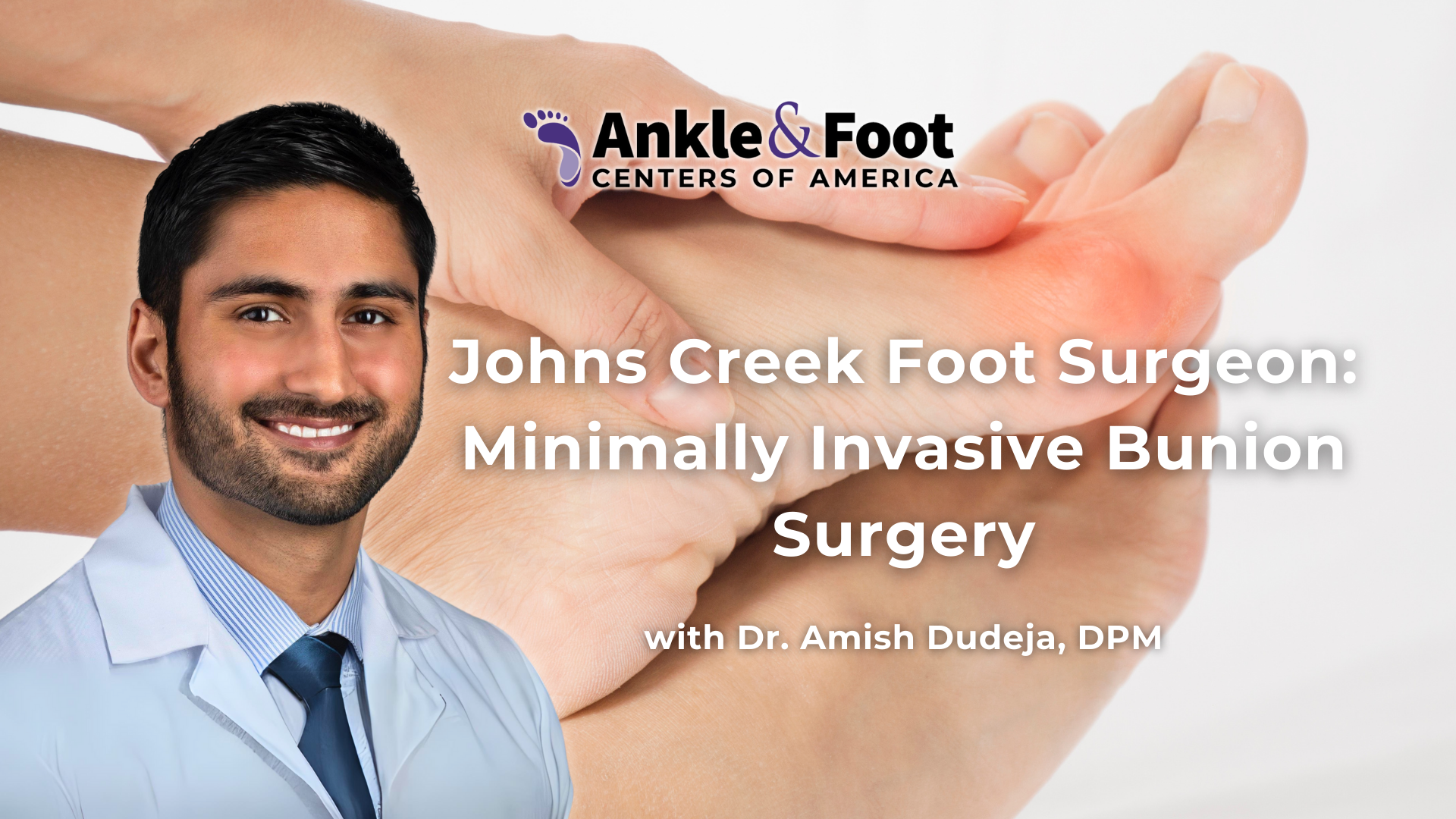Introduction
If bunion pain is affecting your daily life, minimally invasive bunion surgery may offer the relief you need. This advanced procedure is growing in popularity, particularly for those seeking effective results with minimal downtime. For residents in Johns Creek, finding non-invasive bunion surgery nearby is now more convenient than ever, with skilled foot surgeons offering this innovative treatment close to home.
Table of Contents
What is Minimally Invasive Bunion Surgery?
 Minimally invasive bunion surgery is a modern approach to treating bunions without the need for large incisions. Instead of the traditional, open surgery method, this technique uses small cuts and specialized tools to correct the bone alignment. As a result, patients experience fewer complications, less scarring, and faster recovery times.
Minimally invasive bunion surgery is a modern approach to treating bunions without the need for large incisions. Instead of the traditional, open surgery method, this technique uses small cuts and specialized tools to correct the bone alignment. As a result, patients experience fewer complications, less scarring, and faster recovery times.
In a typical procedure, the surgeon makes tiny incisions around the bunion area. Then, using special instruments, they carefully realign the bones in the big toe joint, addressing the painful bump that a bunion causes. This precise approach minimizes the impact on surrounding tissues, which often means less swelling and pain after surgery.
Furthermore, minimally invasive bunion surgery is performed on an outpatient basis, so most patients go home the same day. This method not only reduces hospital time but also allows for a quicker return to normal activities. Overall, it’s an effective and less invasive alternative for those seeking relief from bunion pain without the extended recovery time of traditional surgery.
How Effective is Minimally Invasive Bunion Surgery?
Minimally invasive bunion surgery has proven to be highly effective for most patients, providing long-lasting relief from bunion pain. Unlike traditional surgery, which involves larger incisions, this approach yields similar results with less trauma to the foot.
Many patients report:
- Less pain
- Increased mobility
- Improved foot appearance
This surgery is also effective at correcting bone structure, as it carefully realigns the bones in the big toe joint. This adjustment not only reduces the visible bump but also enhances toe functionality. Studies show that patients often return to daily activities faster, further proving its effectiveness.
Recovery Time and Benefits
 One of the biggest advantages of minimally invasive bunion surgery is its shorter recovery time. Most patients can expect to resume normal activities much sooner than with traditional surgery. Typically, the initial recovery period lasts a few weeks, during which patients may need to wear a protective boot. However, many people can start putting weight on their foot within days, depending on their surgeon’s guidance.
One of the biggest advantages of minimally invasive bunion surgery is its shorter recovery time. Most patients can expect to resume normal activities much sooner than with traditional surgery. Typically, the initial recovery period lasts a few weeks, during which patients may need to wear a protective boot. However, many people can start putting weight on their foot within days, depending on their surgeon’s guidance.
Minimally invasive bunion surgery recovery is generally smoother because the procedure uses small incisions, which reduces trauma to the surrounding tissue. This approach leads to less swelling, minimal scarring, and reduced post-surgical pain. As a result, patients often experience a quicker and more comfortable healing process.
Beyond recovery, the benefits of bunion surgery minimally invasive include a better cosmetic outcome and less risk of complications. The smaller incisions are less noticeable, making the foot look more natural. Additionally, this approach lowers the chances of infection and other post-surgical issues. Overall, minimally invasive bunion surgery not only provides effective pain relief but also improves the appearance and function of the foot, allowing patients to get back to their lives faster and with greater confidence.
Comparing Minimally Invasive vs. Traditional Bunion Surgery
When choosing between minimally invasive bunion surgery and traditional bunion surgery, it’s essential to understand the key differences. Traditional bunion surgery involves larger incisions and more tissue disruption, often resulting in longer recovery times and increased post-surgical pain. In contrast, minimally invasive bunion surgery uses smaller incisions and specialized tools, allowing surgeons to make precise adjustments with less impact on surrounding tissues.
One of the main advantages of minimally invasive surgery is its shorter recovery time. Traditional surgery may require several months for full healing, while patients undergoing minimally invasive surgery often return to daily activities sooner. Additionally, the smaller incisions used in minimally invasive surgery result in less visible scarring, which many patients find more cosmetically appealing.
Both procedures can successfully realign the big toe joint and relieve bunion pain. However, minimally invasive surgery typically results in less swelling, fewer complications, and a lower risk of infection. Overall, minimally invasive bunion surgery provides a less painful and more visually appealing option for bunion correction.
Comparison Summary:
- Traditional surgery: Large incisions, longer recovery, more visible scarring.
- Minimally invasive surgery: Small incisions, faster recovery, less visible scarring.
When considering your options, it’s helpful to discuss these differences with a qualified foot surgeon. Understanding the pros and cons of each approach will enable you to make the best choice for your foot health needs.

Finding a Foot Surgeon for Minimally Invasive Bunion Surgery
 If you’re considering minimally invasive bunion surgery, choosing a skilled foot surgeon is crucial. Ankle & Foot Centers of America offers trusted care through their highly trained specialists, who bring extensive experience in minimally invasive techniques. Dedicated to patient-centered treatment, their team provides advanced, individualized solutions that focus on faster recovery and less post-surgery pain.
If you’re considering minimally invasive bunion surgery, choosing a skilled foot surgeon is crucial. Ankle & Foot Centers of America offers trusted care through their highly trained specialists, who bring extensive experience in minimally invasive techniques. Dedicated to patient-centered treatment, their team provides advanced, individualized solutions that focus on faster recovery and less post-surgery pain.
The surgeons at Ankle & Foot Centers of America are experts in the latest minimally invasive methods, designed to minimize scarring and enhance recovery. With multiple convenient locations, finding a qualified foot surgeon close to you is simple and accessible.
To begin, schedule a consultation with Ankle & Foot Centers of America. Their compassionate team will assess your condition, discuss your goals, and help you determine if minimally invasive bunion surgery is the right fit. With their commitment to quality care and your foot health, you’ll feel confident in taking the next step toward relief.
Conclusion
Minimally invasive bunion surgery offers an effective, less painful solution for bunion relief, helping you get back to daily activities sooner. With smaller incisions, quicker recovery, and reduced risks, this modern approach has become a preferred choice for many. The skilled foot surgeons at Ankle & Foot Centers of America are committed to providing expert, compassionate care to ensure lasting relief.
If you’re ready to explore minimally invasive bunion surgery, schedule a consultation to discuss your options. Their experienced team will guide you, answer your questions, and help you make the best choice for your foot health. Take the first step toward pain-free feet and improved mobility today!






